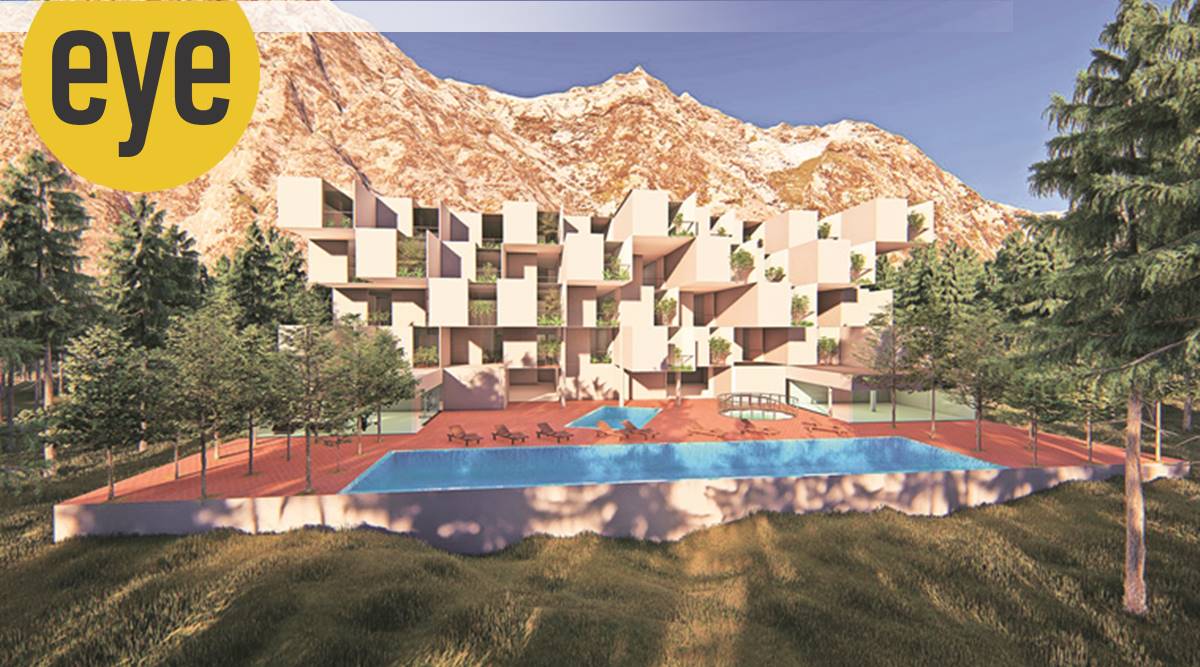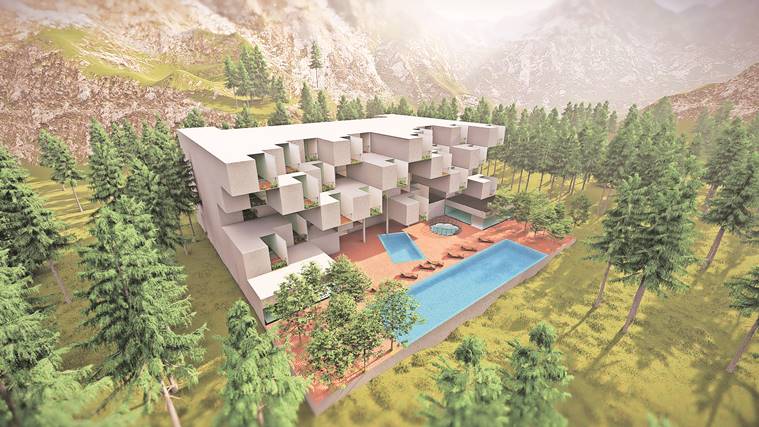 Look in, look out: A rendering of the Pandemic Community House (Photo credit: Gautam Bhatia)
Look in, look out: A rendering of the Pandemic Community House (Photo credit: Gautam Bhatia)
Sometime back, in a film, I saw a gigantic mobile home travelling at high speed on the highway in California. It was hurtling along the coastal road when suddenly a car veered into its path from the opposite direction. To avoid a collision, the mobile home swerved sideways, hit the railing and flew down a deep ravine; it smashed into the rocks far below, and lay upturned and mangled. This was the first time I had seen architecture wrecked so quickly and cleanly. And it reminded me of the fragility of construction, the tentative nature of something considered eternal.
In recent times there has been no better reminder of architecture’s great tragedy than the year-long pandemic. For a short while, people shuttered indoors, and a wholesome world began to bloom outside. Clear blue skies appeared across normally polluted north India; the Yamuna sparkled with unexpected renewal; star-filled nights surprised fearful citizens; birdsongs replaced car horns. In a fittingly ironic twist, as human deaths mounted, doomed species of insects and butterflies revived in a welcoming world. The vacuum of noisy humanity made a temporary ecological balance possible. Could there have been a more picture-perfect message?
Even my own small architecture practice felt the sudden death of an extravagant way of life. Two hotel projects dried up. An office building was put on hold. A resort under construction was left incomplete. The effects of the pandemic on work were keenly felt, but those on the home front were brutal.
For most people, closeted in small apartments, fixated between bedroom and dining table, working from makeshift studies and living rooms, unable to socialise, the burden of imprisonment hung heavy. A destabilising mental state grew progressively difficult through the long isolation. The emptiness of family insularity, skewed relationships between home and workplace, disjointed webinars, and incomprehensible birthday celebrations on Zoom, everyone had begun to feel the strain of the new normal. It was clear that architecture needed a new makeover. It seemed the right time to pursue untested and remote design ideas, however ridiculous and far-fetched.
 Base line: Can home, recreation and work be in a single structure?
Base line: Can home, recreation and work be in a single structure?
A decade earlier, I had worked with a young builder-developer, whose only interest had been luxury housing — 20-storied high rises with lavish “Singapore Style” interiors, with pools, jacuzzis, barbeques and terrace gardens designed by Brazilian landscape firms. With a lively eye for imitation, he appropriated the “luxury” formula to all his projects — the rotating indoor-outdoor fireplace, the infinity pool, cupboards concealed behind movable walls. Having made quite a profit, he retired at 36 into one of his own penthouses overlooking the city.
When COVID fatalities were on the rise and hospitals were filling up, I had approached him with a proposal to build a new type of efficiency housing with home, recreation and work areas built into a single structure. “A close-knit community building, where you share your home and work life, with 40 families,” I said. He just stood at the terrace bar and sneered. With a wistful glance at the distant Humayun’s Tomb he said, “The days of good architecture are over”. Then added, “When I was young, I could think of doing something different. Not now”. In my 60s, this seemed to me to be a truly damning statement coming from a jaded 39-year old. I closed the laptop with its display of Pandemic Community Housing, and sensed that there was some truth in what he said.
The real problem lay in a practised public inertia. We have learnt to do all the wrong things, and do them really well. When 30 million rural homes are still without electricity, the infrastructure push is in a highway programme to connect the major metros with six lanes of concrete tarmac. Will this expensive misuse make sense when drones may be the primary mode of future inter-city transport? With rural schools empty in most parts of the country, does it make sense to maintain an obsolete rural education programme or would they be better converted into health centres or grain silos? Should the building of a democratic capitol esplanade be a national priority or a system of fresh water urban lakes to create natural catchments in parched cities, as proposed by a noted hydrologist?
There are clearly two approaches to creative thinking. The first is formed out of a deeply philosophical basis that stems from unabashed idealism. It approaches the world as a clean slate and places human relations, needs and desires at the centre. Then, and only then, does it apply the structure of life.
The approach that human welfare is of singular importance is visible in some Scandinavian countries; in Costa Rica; and Bhutan, where happiness is a measure of progress. Such societies are profoundly creative, because people’s lives — their health, their cities, their economics, their agriculture and industry — evolve out of a single visionary idea. The second comes from circumstance and opportunity. Could there have been a more lucid moment than the one that revealed a picture of a noiseless unpolluted world? The time to push the reset button is long past. Still, I am grateful that the pandemic has created areas of architectural uncertainty. Even if the answers are yet unclear, in a single medical stroke it has displaced the home and the work place. It has denounced the active, crowded, social and cultural spaces of clubs, of wedding halls and hotels. It has unsettled schools and education, travel and tourism. The floodgates of a re-imagined life have been thrown open.
I end then in hope: A short film demonstrates something of the futility of the old world. A fledgling writer is berated by his wife to abandon his silly novel and get a real job. So, he works out a clever strategy. Every morning dressed in black suit, with a laptop, he strides confidently into one of the many open-plan offices in Manhattan. At an empty workstation, he works on his novel amid a pool of changing employees. If the shifting state of work and office space is now a reality, it signals perhaps the next more important change in architectural priorities: the shifting home. The time isn’t far when open-plan apartments will allow families to occupy space for a day, a week or a month, before they move on to the next building.
 Continue with Facebook
Continue with Facebook Continue with Google
Continue with Google